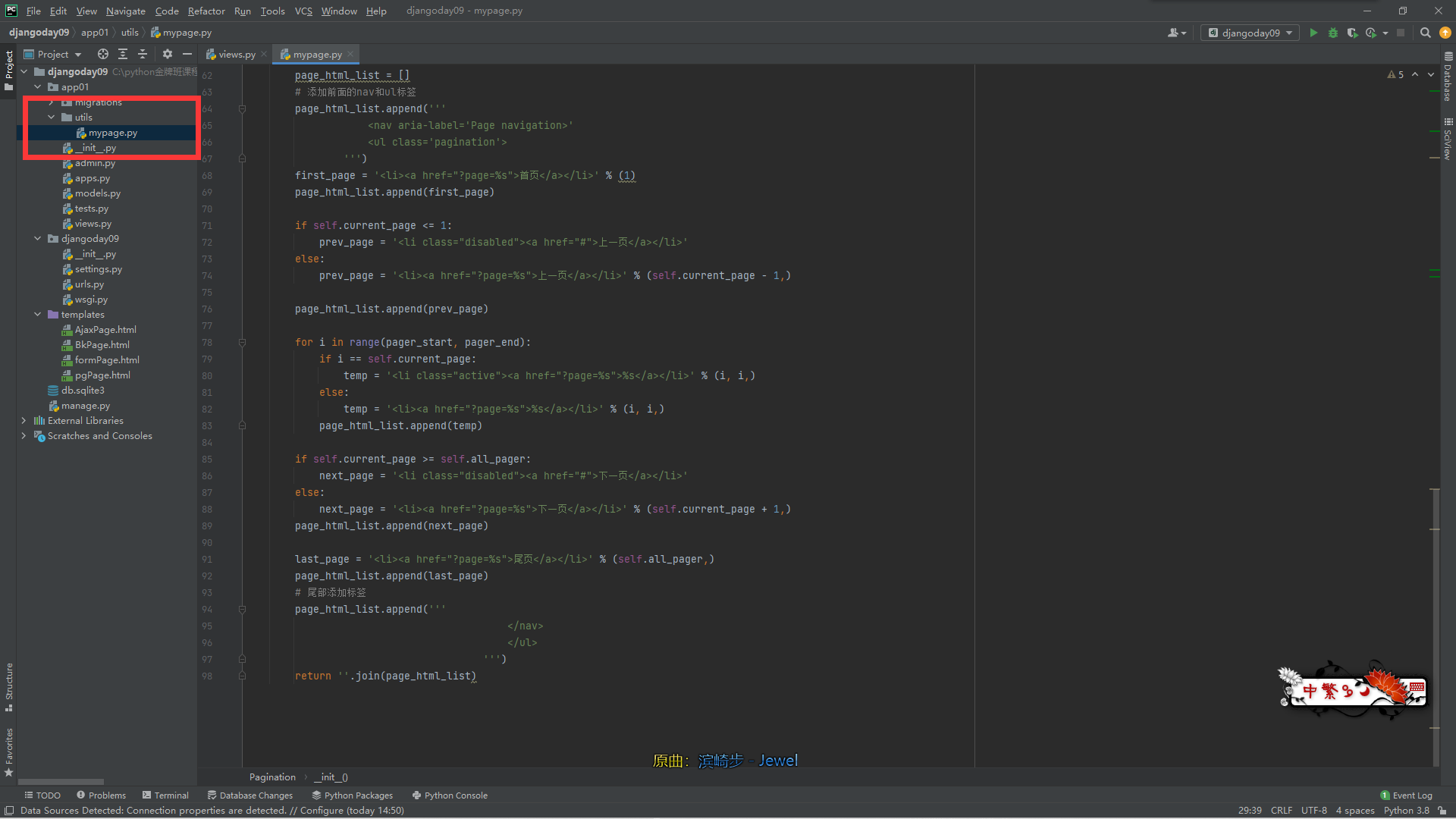django分页器
一、分页器思路
分页器主要听处理逻辑 代码最后很简单
推导流程
1.queryset支持切片操作(正数)
2.研究各个参数之间的数学关系
每页固定展示多少条数据、起始位置、终止位置
3.自定义页码参数
current_page = request.GET.get('page')
4.前端展示分页器样式
5.总页码数问题
divmod方法
6.前端页面页码个数渲染问题
后端产生 前端渲染(通常来说后端返回的都是奇数的页码个数)
部分代码展示
def ab_bk_func(request):
per_page_num = 10 # 每页展示多少条数据
current_page = request.GET.get('page', 1)
try:
current_page = int(current_page)
except BaseException:
current_page = 1
book_queryset = models.Books01.objects.all()
all_count = book_queryset.count()
all_page_num, more = divmod(all_count, per_page_num)
if more:
all_page_num += 1
# 由于模板语法没有range功能 但是我们需要循环产生很多分页标签 所以考虑后端生成传递给html页面
html_str = ''
xxx = current_page
if xxx < 6:
xxx = 6
for i in range(xxx - 5, xxx + 6):
if current_page == i:
html_str += '<li class="active"><a href="?page=%s">%s</a></li>' % (i, i)
else:
html_str += '<li><a href="?page=%s">%s</a></li>' % (i, i)
start_num = (current_page - 1) * per_page_num # 起始展示位置
end_num = current_page * per_page_num # 终止展示位置
book_queryset = book_queryset[start_num:end_num]
return render(request, 'BkPage.html', locals())
"""
per_page_num=10 all_count=100 page_num=10
per_page_num=10 all_count=101 page_num=11
per_page_num=10 all_count=99 page_num=10
我们想通过代码动态计算出总共需要多少页
"""
"""
per_page_num = 10
current_page start_num end_num
1 0 10
2 10 20
3 20 30
per_page_num = 5
current_page start_num end_num
1 0 5
2 5 10
3 10 15
start_num = (current_page - 1) * per_page_num
end_num = current_page * per_page_num
"""
二、自定义分页器的使用
django自带分页器模块但是使用起来很麻烦 所以我们自己封装了一个(只需要掌握使用方式即可,以后用的不多)
步骤一:在应用目录下创建一个文件夹,比如utils文件夹,并在该目录下创建一个py文件(如mypage.py)

步骤二:复制自定义分页器的代码到我们创建的py文件中
class Pagination(object):
def __init__(self, current_page, all_count, per_page_num=2, pager_count=11):
"""
封装分页相关数据
:param current_page: 当前页
:param all_count: 数据库中的数据总条数
:param per_page_num: 每页显示的数据条数
:param pager_count: 最多显示的页码个数
"""
try:
current_page = int(current_page)
except Exception as e:
current_page = 1
if current_page < 1:
current_page = 1
self.current_page = current_page
self.all_count = all_count
self.per_page_num = per_page_num
# 总页码
all_pager, tmp = divmod(all_count, per_page_num)
if tmp:
all_pager += 1
self.all_pager = all_pager
self.pager_count = pager_count
self.pager_count_half = int((pager_count - 1) / 2)
@property
def start(self):
return (self.current_page - 1) * self.per_page_num
@property
def end(self):
return self.current_page * self.per_page_num
def page_html(self):
# 如果总页码 < 11个:
if self.all_pager <= self.pager_count:
pager_start = 1
pager_end = self.all_pager + 1
# 总页码 > 11
else:
# 当前页如果<=页面上最多显示11/2个页码
if self.current_page <= self.pager_count_half:
pager_start = 1
pager_end = self.pager_count + 1
# 当前页大于5
else:
# 页码翻到最后
if (self.current_page + self.pager_count_half) > self.all_pager:
pager_end = self.all_pager + 1
pager_start = self.all_pager - self.pager_count + 1
else:
pager_start = self.current_page - self.pager_count_half
pager_end = self.current_page + self.pager_count_half + 1
page_html_list = []
# 添加前面的nav和ul标签
page_html_list.append('''
<nav aria-label='Page navigation>'
<ul class='pagination'>
''')
first_page = '<li><a href="?page=%s">首页</a></li>' % (1)
page_html_list.append(first_page)
if self.current_page <= 1:
prev_page = '<li class="disabled"><a href="#">上一页</a></li>'
else:
prev_page = '<li><a href="?page=%s">上一页</a></li>' % (self.current_page - 1,)
page_html_list.append(prev_page)
for i in range(pager_start, pager_end):
if i == self.current_page:
temp = '<li class="active"><a href="?page=%s">%s</a></li>' % (i, i,)
else:
temp = '<li><a href="?page=%s">%s</a></li>' % (i, i,)
page_html_list.append(temp)
if self.current_page >= self.all_pager:
next_page = '<li class="disabled"><a href="#">下一页</a></li>'
else:
next_page = '<li><a href="?page=%s">下一页</a></li>' % (self.current_page + 1,)
page_html_list.append(next_page)
last_page = '<li><a href="?page=%s">尾页</a></li>' % (self.all_pager,)
page_html_list.append(last_page)
# 尾部添加标签
page_html_list.append('''
</nav>
</ul>
''')
return ''.join(page_html_list)
步骤三:自定义分页器的使用
后端代码
每个变量名的含义可以参考源码的注释
封装分页相关数据
:param current_page: 当前页
:param all_count: 数据库中的数据总条数
:param per_page_num: 每页显示的数据条数
:param pager_count: 最多显示的页码个数
def get_book(request):
book_list = models.Book.objects.all()
current_page = request.GET.get("page",1)
all_count = book_list.count()
page_obj = Pagination(current_page=current_page,all_count=all_count,per_page_num=10)
page_queryset = book_list[page_obj.start:page_obj.end]
return render(request,'booklist.html',locals())
前端代码
ps:需要有bootstrap样式
<div class="container">
<div class="row">
<div class="col-md-8 col-md-offset-2">
{% for book in page_queryset %}
<p>{{ book.title }}</p>
{% endfor %}
{{ page_obj.page_html|safe }}
</div>
</div>
</div>



【推荐】国内首个AI IDE,深度理解中文开发场景,立即下载体验Trae
【推荐】编程新体验,更懂你的AI,立即体验豆包MarsCode编程助手
【推荐】抖音旗下AI助手豆包,你的智能百科全书,全免费不限次数
【推荐】轻量又高性能的 SSH 工具 IShell:AI 加持,快人一步
· winform 绘制太阳,地球,月球 运作规律
· AI与.NET技术实操系列(五):向量存储与相似性搜索在 .NET 中的实现
· 超详细:普通电脑也行Windows部署deepseek R1训练数据并当服务器共享给他人
· 【硬核科普】Trae如何「偷看」你的代码?零基础破解AI编程运行原理
· 上周热点回顾(3.3-3.9)